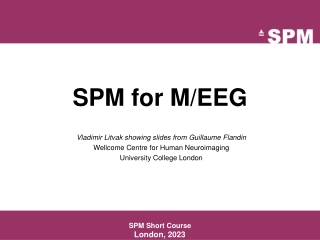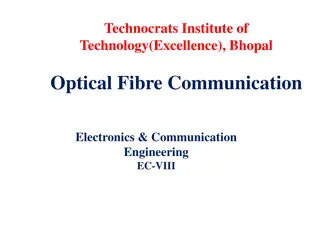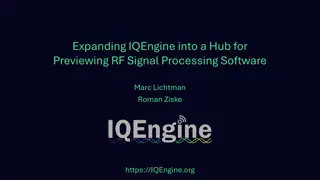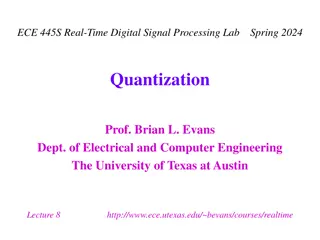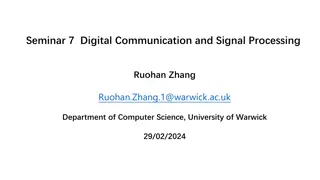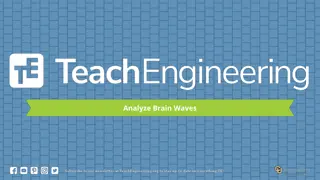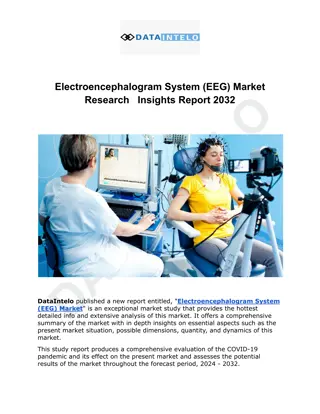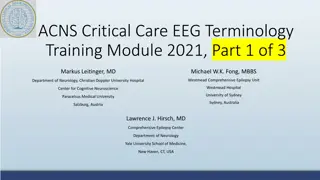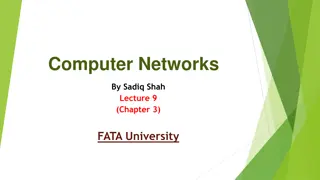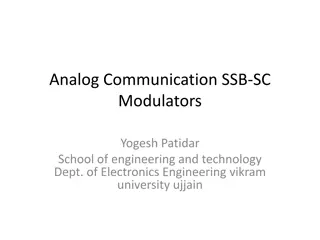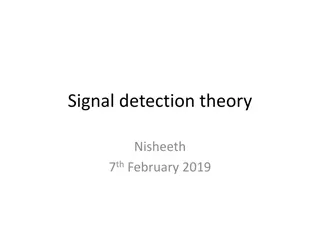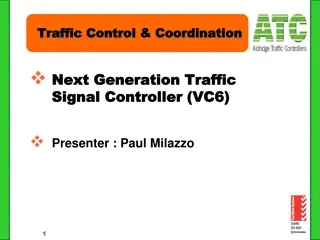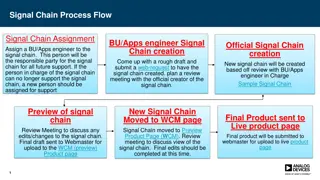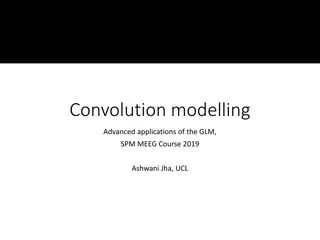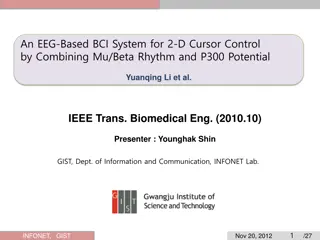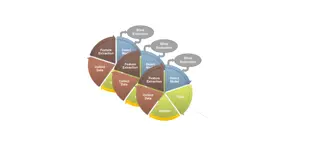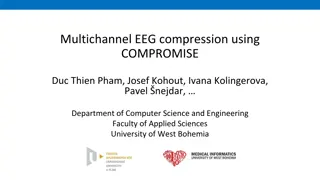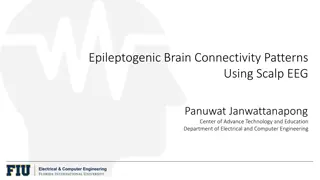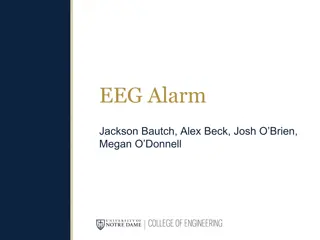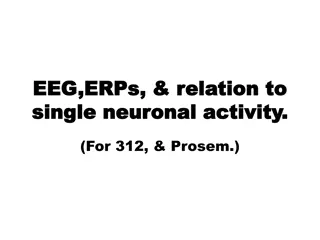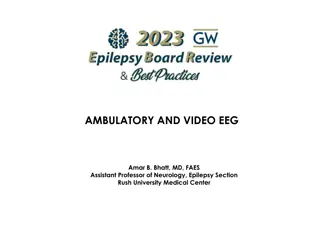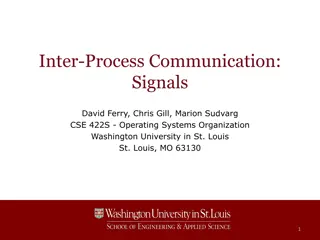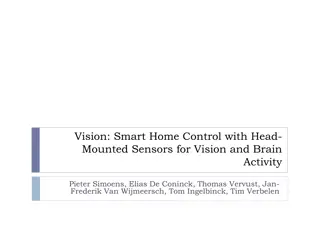SPM for M/EEG
The powerful SPM software for routine statistical analysis of functional neuroimaging data from M/EEG. Learn about its origins, advancements, and applications in a comprehensive short course.
0 views • 17 slides
Cognitive Load Classification with 2D-CNN Model in Mental Arithmetic Task
Cognitive load is crucial in assessing mental effort in tasks. This paper discusses using EEG signals and a 2D-CNN model to classify cognitive load during mental arithmetic tasks, aiming to optimize performance. EEG signals help evaluate mental workload, although they can be sensitive to noise. The
0 views • 19 slides
Basis of the M/EEG signal
This informative guide delves into the basics of M/EEG signal methods, covering topics such as the biophysical origin of M/EEG, historical background, measurement techniques, and the distinction between EEG and MEG. It explores the history of human EEG, the concept of action potentials, and the prac
0 views • 32 slides
Understanding Data Acquisition and Instrument Interface
In the realm of data acquisition and instrument interface, various components come together to sense physical variables, condition electrical signals, convert analog to digital data, and analyze the acquired information. This process involves transducers, signal analysis, instrument automation, and
3 views • 54 slides
Understanding Interpolation and Pulse Shaping in Real-Time Digital Signal Processing
Discrete-to-continuous conversion, interpolation, pulse shaping techniques, and data conversion in real-time digital signal processing are discussed in this content. Topics include types of pulse shapes, sampling, continuous signal approximation, interpolation methods, and data conversion processes
4 views • 14 slides
Understanding Optical Fiber Signal Degradation in Communication Engineering
Technocrats Institute of Technology (Excellence) in Bhopal delves into the concepts of signal degradation in optical fiber communication, focusing on attenuation, distortion mechanisms, and measurement techniques. The institute emphasizes the importance of signal attenuation and its impact on inform
4 views • 56 slides
Expanding IQEngine: A Hub for Previewing RF Signal Processing Software
IQEngine is evolving into a versatile hub where users can manage, analyze, process, and share RF signal recordings directly in their browser. Built on an open standard, IQEngine stores data such as sample rate, center frequency, and IQ data type to prevent data degradation. Frontend powered by React
7 views • 22 slides
Real-Time Digital Signal Processing Lab: Quantization and Resolution Overview
Explore quantization and resolution techniques in real-time digital signal processing. Topics include quantization error analysis, total harmonic distortion, noise immunity in communication systems, human sensory resolution, analog-to-digital conversion, and uniform amplitude quantization. Dive into
7 views • 19 slides
Exercise Evaluation Training
Controllers and Evaluators play crucial roles in exercise evaluation. Controllers ensure the exercise meets objectives while maintaining safety and focus. Evaluators organize evaluation, observe, and collect data to identify strengths and areas for improvement. Exercise Evaluation Guide (EEG) provid
1 views • 14 slides
Seminar 7 Digital Communication and Signal Processing
Learn how to design a second order ARMA filter to suppress sinusoidal disturbances in a signal while preserving the original signal. The process involves deriving the transfer function, determining coefficients, and sketching a block diagram representation of the filter.
0 views • 7 slides
Exploring Brain Waves Through EEG Analysis
Delve into the world of brain waves with EEG, EKG, and EMG measurements. Learn how to analyze brain wave data using mathematical processes like Fast Fourier Transform (FFT) and Power Spectral Density (PSD). Discover the significance of different frequencies in brain wave signals and how they reflect
0 views • 13 slides
Electroencephalogram System (EEG) Market Research Insights Report 2032
The global electroencephalogram system (EEG) market size was USD 1.03 Billion in 2023 and is projected to reach USD 1.78 Billion by 2032, expanding at a CAGR of 6.3% during 2024\u20132032.
0 views • 5 slides
Understanding ACNS Critical Care EEG Terminology 2021: Part 1 of 3
This module provides an introduction to the important components of the ACNS standardized critical care EEG terminology for 2021. It discusses common terms and components of EEG background, sporadic epileptiform discharges, rhythmic and periodic patterns (RPPs), electrographic and electroclinical se
1 views • 41 slides
Understanding Inter-Process Communication Signals in Operating Systems
Signals in inter-process communication are asynchronous notifications delivered to specific processes, allowing event-based programming. Processes can handle signal delivery by ignoring it, terminating, or invoking a signal handler. Signal handlers can be written in two ways - one handler for many s
0 views • 21 slides
Smart Antenna Systems Overview: Enhancing Wireless Performance
Smart antenna systems, like adaptive array antennas and switched beam antennas, combine antenna arrays with digital signal processing to transmit and receive signals adaptively. These systems improve signal quality, reduce interference, and increase capacity by dynamically adjusting radiation patter
0 views • 20 slides
Understanding Transmission Impairments in Computer Networks
Signals traveling through transmission media in computer networks can experience attenuation, distortion, and noise, leading to signal loss and changes in form or shape. Attenuation results in energy loss requiring amplification, while distortion alters the signal's composition. Engineers use decibe
1 views • 12 slides
Understanding SSB-SC Modulation in Analog Communication
Single Sideband Suppressed Carrier (SSB-SC) modulation is a technique in analog communication that transmits a single sideband along with the carrier signal, offering advantages such as reduced bandwidth consumption, increased signal transmission capacity, and lower noise interference. However, the
0 views • 9 slides
Comparison of SedLine and BIS Depth of Sedation Performance in General Anesthesia
This study evaluates the performance of SedLine and BIS monitoring devices in measuring anesthetic depth during general anesthesia. The research protocol aims to compare processed EEG indices from both monitors across various levels of anesthetic depth using a custom interface box. Inclusion criteri
0 views • 10 slides
Overview of Digital Signal Processing (DSP) Systems and Implementations
Recent advancements in digital computers have paved the way for Digital Signal Processing (DSP). The DSP system involves bandlimiting, A/D conversion, DSP processing, D/A conversion, and smoothing filtering. This system enables the conversion of analog signals to digital, processing using digital co
0 views • 24 slides
Understanding Signal Detection Theory in Psychophysics
Signal Detection Theory in psychophysics quantifies how observers respond to signals in noise. It involves mathematical models like psychometric functions to measure bias and sensitivity in detecting stimuli. Key concepts include sensitivity and criterion in distinguishing signal perception and repo
6 views • 24 slides
Traffic Control and Coordination: Next Generation Signal Controller Overview
Explore the evolution of traffic signal controllers in Australia, from VC5 to VC6, along with the software integration and system overview. Learn about the hardware configurations and capabilities of the latest TSC/4 controllers, including signal group monitoring and conflict capabilities. The new g
4 views • 10 slides
EEG Conformer: Convolutional Transformer for EEG Decoding and Visualization
This study introduces the EEG Conformer, a Convolutional Transformer model designed for EEG decoding and visualization. The research presents a cutting-edge approach in neural systems and rehabilitation engineering, offering advancements in EEG analysis techniques. By combining convolutional neural
1 views • 6 slides
Mastering the Art of Introducing Quotes with Signal Phrases
Understanding the importance of signal phrases in academic writing. Signal phrases provide context, establish credibility of sources, and prevent dropped quotes. Learn the key elements required for an effective signal phrase and how to structure them using different formulas. Enhance your writing by
1 views • 16 slides
Developing and Managing Signal Chains for Future Support
Create a system to assign a responsible person for signal chains, initiate the chain creation process, review and finalize the signal chain, and move it to the live product page. Guidelines include color codes for blocks, assigning part numbers to each block, and adding images to the signal chain.
1 views • 4 slides
Advancements in Signal Processing for ProtoDUNE Experiment
The team, including Xin Qian, Chao Zhang, and Brett Viren from BNL, leverages past experience in MicroBooNE to outline a comprehensive work plan for signal processing in ProtoDUNE. Their focus includes managing excess noise, addressing non-functional channels, and evolving signal processing techniqu
1 views • 23 slides
Comprehensive Training Package on Active Tuberculosis Drug Safety Monitoring and Management (aDSM) 2023
This training package focuses on signal detection in active tuberculosis drug safety monitoring. It covers the main aims and principles of signal detection, completion of safety profiles for new TB drugs and regimens, definition of signal, continuous reporting activities, construction of risk profil
5 views • 15 slides
Kingwood Traffic Signals Overview and Updates
Traffic operations in Kingwood, managed by Johana E. Clark, P.E., include signal system improvements and updates. Recent changes involve signal removal studies, new signal installations, and upgrades at key intersections to enhance traffic flow and safety. The system's capacity and daily traffic vol
1 views • 11 slides
Carnegie Mellon Algebraic Signal Processing Theory Overview
Carnegie Mellon University is at the forefront of Algebraic Signal Processing Theory, focusing on linear signal processing in the discrete domain. Their research covers concepts such as z-transform, C-transform, Fourier transform, and various signal models and filters. The key concept lies in the al
2 views • 40 slides
Advanced Applications of Convolution Modelling in GLM and SPM MEEG Course 2019
Addressing difficulties in experimental design such as baseline correction, temporally overlapping neural responses, and systematic differences in response timings using a convolution GLM, similar to first-level fMRI analysis. The course focuses on the stop-signal task, EEG correlates of stopping a
0 views • 21 slides
EEG-Based BCI System for 2-D Cursor Control Combining Mu/Beta Rhythm and P300 Potential
Brain-computer interfaces (BCIs) offer a pathway to translate brain activities into computer control signals. This paper presents a novel approach for 2-D cursor control using EEG signals, combining the Mu/Beta rhythm and P300 potential. By simultaneously detecting two brain signals, P300 and motor
0 views • 27 slides
Advanced Applications of GLM and SPM in M/EEG Course 2018
This course delves into utilizing Convolution GLM to address challenges such as baseline correction, overlapping neural responses, and systematic response timing differences in EEG experiments. It focuses on the stop-signal task, EEG correlates of movement stopping, and MEG data analysis. The course
0 views • 26 slides
Analysis of Deep Learning Models for EEG Data Processing
This content delves into the application of deep learning models, such as Sequential Modeler, Feature Extraction, and Discriminator, for processing EEG data from the TUH EEG Corpus. The architecture involves various layers like Convolution, Max Pooling, ReLU activation, and Dropout. It explores temp
0 views • 15 slides
Multichannel EEG Compression Using COMPROMISE Study
A study on multichannel EEG compression using COMPROMISE by Duc Thien Pham, Josef Kohout, Ivana Kolingerova, Pavel Nejdar from the Department of Computer Science and Engineering, Faculty of Applied Sciences, University of West Bohemia. The study covers datasets, methods, and discussions related to E
0 views • 12 slides
Uncovering Epileptogenic Brain Connectivity Patterns Through Scalp EEG
Epilepsy is a common neurological disorder characterized by unprovoked seizures, affecting a significant portion of the population. Enhancing the diagnosis and prediction of seizures through EEG recordings can improve therapeutic strategies for epilepsy patients. Functional connectivity analysis in
0 views • 21 slides
Innovative Sleep Monitoring Device for Improved Rest
EEG Alarm by Jackson Bautch, Alex Beck, Josh O'Brien, and Megan O'Donnell offers a solution to track sleep stages throughout the night using Electroencephalogram (EEG) technology. With fewer electrodes and a compact design, the device sends sleep data to the user's phone and sets off an alarm during
0 views • 7 slides
Understanding the Relationship between EEG, ERPs, and Single Neuronal Activity
This detailed information discusses the relationship between EEG, ERPs, and single neuronal activity, exploring how electrodes record signals based on tip diameter and biological amplifier filter settings. It delves into parameters that determine what an electrode records, highlighting the importanc
0 views • 56 slides
Understanding Video-EEG Monitoring in Neurology
Detailed information on the uses, options, and activation procedures for Video-EEG monitoring in neurology, focusing on diagnosis, interictal epileptiform discharges, medication adjustment, and surgical candidacy evaluation. Learn about the yield of EEG monitoring, methods to increase yield, and dif
0 views • 43 slides
Understanding Inter-Process Communication Signals in Operating Systems
Signals in operating systems play a critical role in facilitating asynchronous notifications between processes. They allow for event-based programming and are conceptually similar to hardware interrupts and exceptions. Processes can handle signal delivery by ignoring it, terminating, or invoking a s
0 views • 24 slides
Combined Classification and Channel Basis Selection with L1-L2 Regularization for P300 Speller System
This study presents a method that combines classification and channel basis selection using L1-L2 regularization for the P300 Speller System. The approach involves EEG signal processing, feature extraction, P300 detection, and character decoding. The proposed method aims to improve decoding accuracy
0 views • 17 slides
Smart Home Control with Head-Mounted Sensors
Wearable ubiquitous computers like smart glasses and neuro-headsets are utilized to achieve ubiquitous computing in smart homes. A vision system is proposed that combines visual cues and cognitive signals to enable users to control household objects using brain activity. The prototype integrates cam
0 views • 8 slides
